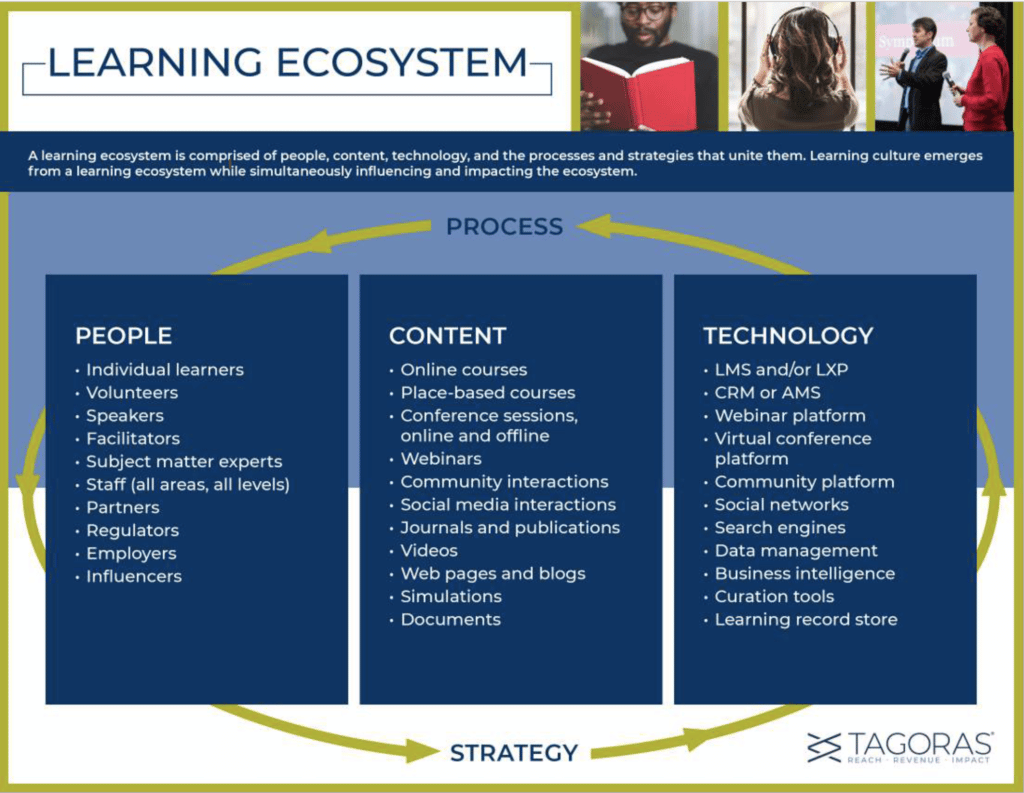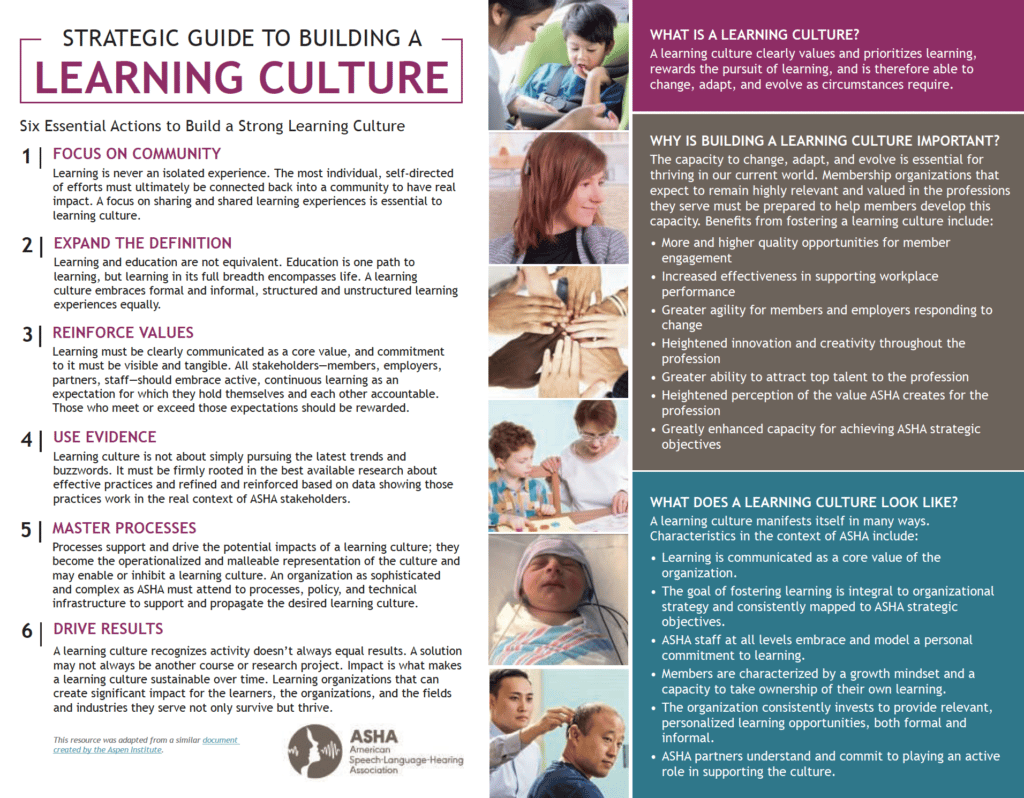We’ve said it before, and we’ll say it again: Learning is process, not an event.
Learning experiences are embedded in culture and are part of a broader ecosystem. And, as leaders in the business of lifelong learning, it’s critical that we embrace this and the related impact we can have.
In this sixth episode in our informal series on tools for learning businesses, we explore the concepts of learning culture and learning ecosystem: what they are, why you should focus on them, and how to foster them.
To tune in, listen below. To make sure you catch all future episodes, be sure to subscribe via RSS, Apple Podcasts, Spotify, Stitcher Radio, iHeartRadio, PodBean, or any podcatcher service you may use (e.g., Overcast). And, if you like the podcast, be sure to give it a tweet.
Listen to the Show
Access the Transcript
Download a PDF transcript of this episode’s audio.
Read the Show Notes
[00:00] – Intro
Why Should You Focus on Your Learning Culture and Learning Ecosystem?
[01:53] – “Learning culture” and “learning ecosystem” are terms that have been trendy in the corporate L&D world for years. But they seem less prevalent in the world of market-facing learning businesses where the audiences we serve are often widely distributed and less in our direct control when compared to an internal audience of corporate employees.
It feels easier to talk about culture in the context of a single, well-defined organization where there are common rules and structures that are understood and shared. Even when focused on a specific profession or industry, learning businesses serve people from a wide range of organizations that can be very different from each other.
A learning ecosystem is usually tied to technology systems, and it can feel easier to have control over systems and how they relate to each other in the more defined environment of a single organization.
That said, we’re seeing more learning businesses embrace a learning culture and a learning ecosystem. We suspect one reason is the evolving understanding of learning and how we as learning businesses and learning leaders can deliver higher value with the experiences we offer.
Core to that shift and evolution is a point we have made many times before: Learning is not an event; it’s a process. But that process isn’t linear or isolated.
Even our most clearly defined learning experiences happen in interaction with other people and our environment, and they’re influenced by countless other processes unfolding in our lives.
In other words, learning experiences are embedded in a culture and are part of a broader ecosystem. Of course, many—arguably most—of our learning experiences are not clearly defined. They emerge organically from our daily experiences.
Most of the focus of learning businesses historically has been on what might be described as “point-in-time solutions”: classes, courses, and conference sessions that are blips in the overall context of a learner’s life and career. Those blips fade rapidly, often leaving little trace behind.
If we’re going really support lifelong learning rather than just being in the education business or the events business, if we are, in fact, going to lead learning in the fields and industries we serve, then we must understand and address each learner’s need in context, over time. And we must understand that we have some ability to not just to react to context, but also to influence and shape it.
Celisa Steele
We now have more ability to foster ecosystems that then influence and foster culture among the audiences we serve. Advances in technology have played a major role in this increased ability.
Our ability to reach and connect with more learners has changed the learning landscape permanently, and artificial intelligence and personalization will also going to leave an indelible mark.
Simply implementing better technology won’t carry us into the future of learning, though.
The key is in our relationships with our learners and with the sense of vision and purpose that we bring to our work. These are the factors that should drive how we think about and shape both learning culture and learning ecosystem.
Partner with Tagoras
[06:09] – At Tagoras, we’re experts in the global business of lifelong learning, and we use our expertise to help clients better understand their markets, connect with new customers, make the right investment decisions, and grow their learning businesses.
We achieve these goals through expert market assessment, strategy formulation, and platform selection services. If you are looking for a partner to help your learning business achieve greater reach, revenue, and impact, learn more at tagoras.com/services.
What Is a Learning Culture?
[06:42] – Culture is a cohesive, integrated, and persistent pattern of knowledge, belief, and behavior exhibited by a group of human beings.
Learning may be defined as “the lifelong process of transforming information and experience into knowledge, skills, behaviors, and attitudes.” (This definition comes from our sister site Mission to Learn.)
Combining those two definitions, we get that a learning culture is one in which the process of learning drives the pattern of culture. Learning is among the highest values of the group of people involved, and learning, because it inherently leads to change, enables and drives the evolution of the culture.
A learning culture is a culture that clearly values and prioritizes learning, rewards the pursuit of learning, and is therefore able to change, adapt, and evolve as circumstances require.
For a learning business, this culture is not confined to a single organization. It extends out to the broader community, field, or industry the learning business serves.
As a prerequisite to supporting the broader culture, the learning business needs a strong internal learning culture. It’s difficult to model something that you have not fully appreciated or integrated into your own practices.
While formal education and training can be important elements of a learning culture, there’s nothing about learning culture per se that requires formal education and training experiences.
Living itself is learning, and participants in a learning culture recognize that equivalence. This recognition shapes their mindset.
Too much focus on training and education can impede a learning culture if those training and education experiences—and the credit associated with them—evolve to act as a proxy for true, meaningful learning.
Simply putting in the time or checking the box for a formal educational activity might be perceived as learning, but, in reality, it’s possible that very little is gained from that experience.
Finally, a true learning culture is never fixed or static. It’s emergent, representing the continuing accumulation of interactions within the culture, the emergence of patterns. And, because this is the case, learning culture can’t really be prescribed or dictated. It can only be influenced and fostered.
Jeff Cobb
A learning culture by its very nature requires social interaction and community. Those seeking to influence and foster a learning community must be meaningful participants in those interactions and community.
What Is a Learning Ecosystem?
[10:06] – An ecosystem in nature is a community of living beings interacting with each other and their environment. When healthy, an ecosystem is characterized by balance and an innate understanding that no single part is more important than any other and that changes in one part of the ecosystem may impact other parts of the ecosystem.
Ecosystem is an apt metaphor to apply to learning because learning is fundamentally about interactions among human beings and their environment, or context.
We have the ability to shape and influence a learning ecosystem through decisions about the people involved, the substance of the learning experiences that we offer, and the tools and technologies that we use to support and connect those people and those learning experiences.
A learning ecosystem is comprised of people, content, technology, and the processes and strategies that unite them.
The whole of a learning ecosystem is greater than the sum of its parts. Learning culture emerges from a learning ecosystem while simultaneously influencing and impacting that ecosystem, and, just as culture is dynamic and evolving, the ecosystem too is dynamic and evolving.
The two concepts really are inseparable from each other. There are two sides of the same coin—or, borrowing from the Irish poet William Butler Yeats, they’re as hard to distinguish from each other as the dancer and the dance.
O body swayed to music, O brightening glance,
William Butler Yeats, from “Among School Children”
How can we know the dancer from the dance?
While firm control of culture and ecosystem is impossible, decisions made about an ecosystem do impact the ecosystem’s health and, by extension, the health and efficacy of the learning culture.
As in nature, too much of an emphasis on any one factor could negatively impact the whole. So learning ecosystem decisions need to always be made with the desired outcomes in mind, and those desired outcomes might include the desired learning culture.
How Do You Foster a Learning Culture and a Learning Ecosystem?
[13:24] – This is where our tools come in. We have two simple frameworks and visuals that can help you introduce and operationalize the concepts of learning culture and learning ecosystem in your organization and among its stakeholders.
These tools are useful as a way to get meaningful conversations started, to provide common points of reference for communicating key concepts, and to help you move from ideas into concrete action.
Learning Ecosystem
People, content, and technology are at the core of a learning ecosystem. To make decisions about these components—decisions that will influence and shape the ecosystem—you need to be clear about what they are.
For people, list out the key stakeholder groups involved, from the learners to staff to subject matter experts to partners, regulators, and anyone else who plays an important role in your learning ecosystem.
For content, list out the different types of learning content you provide or aspire to provide in the coming years.
For technology, list out the types of technology that are or will be a part of your desired learning ecosystem.
Download the sample learning ecosystem snapshot, which has sample lists for people, content, and technology, each in a box. Arrows surround the boxes and indicate that strategies and processes inform and guide choices about people, content, and technology.
We’ve included our definition of “learning ecosystem” in the snapshot you can download and use as a conversation starter and communication tool around the concept of learning ecosystem.
You can use the sample learning ecosystem snapshot to create your own. We find it useful and powerful to have a short document that provides a snapshot of your learning ecosystem.
Learning Culture
[16:38] – We’ve a created a similar snapshot for learning culture. To create the sample, we addressed four questions that we feel contribute to effectively defining and guiding learning culture:
- What is learning culture?
- Why is building a learning culture important?
- What does a learning culture look like?
- What actions are essential for building a learning culture?
These are questions you’ll need to reflect on, discuss, and answer for your learning business. You may need to do some research and outreach to your broader stakeholder base to arrive at well-informed, accurate answers.
Download an example learning culture snapshot developed for the American Speech-Language-Hearing Association (ASHA). It shows what organizing and presenting answers to the four questions might look like.
This is an example you may use to inform your own approach.
You can be more or less ambitious in creating your snapshots, but having attractive, clear, short documentation of how your organization is approaching its learning culture and ecosystem is important to ensuring success.
[18:02] – With your success in mind, we want to offer some thoughts about fostering a learning culture and ecosystem.
Very few learning businesses start from a blank slate with respect to either culture or ecosystem. There are usually already elements of each in place, both in your learning business and in the broader community, field, or industry you serve.
Do the work to assess your current culture and ecosystem, to establish a vision for the desired future state of your culture and ecosystem, and then consciously set about influencing each in a positive direction. This work elevates the range, relevance, and quality of learning experiences you can offer to each individual learner.
For most learning businesses, this will require a shift in mindset across the stakeholder base—not only staff, board members, and volunteers but also learners themselves.
In the world of adult lifelong learning, we tend to be validation-centric, viewing experiences associated with continuing education, certification, and other forms of credit as valid learning experiences. This bias is usually unconscious, but it confuses education and learning to the detriment of learning.
As an initial step toward prioritizing learning ecosystem and learning culture, the bias needs to be made conscious across the stakeholder base. Make a more conscious effort to support more informal opportunities as well as opportunities that are not “one size fits all.”
This is not to say there’s no place for traditional formal approaches. Rather, it is a call for a shift in emphasis and a recognition that, while formal education certainly can and should play a key role in supporting a learning culture, an excessive focus on it can make it difficult to realize the potential of other, less formal elements as well as to personalize experiences to the needs of individual learners.
Gather the right group of people and ask the question, “How else, beyond what we have traditionally done, could we foster and support learning for the people we serve?”
For most organizations this can be a simple but very powerful first step toward shifting mindset and beginning to identify the opportunities that a focus on learning ecosystem and learning culture can represent.
We encourage you to start work now. Put the wheels in motion to gather the right people, ask that single question, and use that as the basis for putting together snapshots for your learning culture and your learning ecosystem.
[21:56] – Wrap-up
To make sure you don’t miss new episodes, we encourage you to subscribe via RSS, Apple Podcasts, Spotify, Stitcher Radio, iHeartRadio, PodBean, or any podcatcher service you may use (e.g., Overcast). Subscription numbers give us some data on the impact of the podcast.
We’d also be grateful if you would take a minute to rate us on Apple Podcasts at https://www.leadinglearning.com/apple or wherever you listen. We personally appreciate reviews and ratings, and they help us show up when people search for content on leading a learning business.
Finally, consider following us and sharing the good word about Leading Learning. You can find us on Twitter, Facebook, and LinkedIn.
Episodes on Related Topics:
- The Mainstreaming of Lifelong Learning
- Exploring What It Means to Lead Learning
- The Upskilling Imperative with Shelley Osborne of Udemy
- Tool Talk: The Learner Engagement Loop
Related posts:





 Walking the Path to Learning with Tiffany Crosby
Walking the Path to Learning with Tiffany Crosby
Leave a Reply